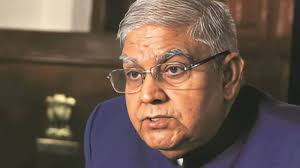Whip System in Indian Parliament

- 27 Jan 2025
In News:
Vice President Jagdeep Dhankhar recently criticized the party whip system, arguing that it curtails the freedom of expression of Members of Parliament (MPs) and enforces servility by mandating strict adherence to the party line. His remarks have sparked a renewed debate on the balance between party discipline and individual autonomy in a parliamentary democracy.
What is a Party Whip?
A whip in parliamentary parlance is both a directive and a designated official of a political party. The directive instructs legislators on voting behavior on specific issues such as bills, motions, or resolutions. The designated whip ensures attendance, adherence, and discipline within the party ranks.
- The term “whip” originated from England’s hunting tradition, where a “whipper-in” kept hounds within the pack.
- The political usage dates back to Edmund Burke in the British Parliament.
- In India, the whip system has been in place since the start of parliamentary governance.
Constitutional and Legal Framework
- The whip system is not mentioned in the Constitution, Rules of Procedure, or any statute, but functions through parliamentary conventions.
- The Anti-Defection Law (52nd Amendment, 1985) enforces the whip by allowing disqualification of MPs/MLAs for defying it, thus preserving political stability and party integrity.
Quorum Requirement: As per Article 100 of the Constitution, quorum in Parliament is one-tenth of the total membership:
- Lok Sabha: 55 members
- Rajya Sabha: 25 members
Types of Whips
- One-Line Whip: Informational—members may abstain.
- Two-Line Whip: Requires presence but does not dictate voting.
- Three-Line Whip: Strictest—mandates attendance and voting as directed.
- Violation can lead to disqualification under the Anti-Defection Law, unless two-thirds of the party members dissent together.
Functions and Significance
- Ensures Attendance: Maintains quorum during critical votes.
- Secures Support: Helps pass or oppose legislation.
- Maintains Discipline: Prevents cross-voting or defection.
- Internal Monitoring: Identifies discontent among MPs and informs party leadership.
- Party Cohesion: Acts as a channel between MPs and party high command.
- Democratic Functioning: Ensures government stability, especially during division voting, where numbers decide the fate of motions like the No-Confidence Motion.
For ruling coalitions, a united stance during such votes is crucial to showcase majority strength.
Chief Whip and Institutional Structure
- The Chief Whip is the most critical functionary in enforcing the whip.
- In the Lok Sabha, the Minister of Parliamentary Affairs usually acts as the government’s chief whip.
- In the Rajya Sabha, it is the Minister of State for Parliamentary Affairs.
- Whips also coordinate which MPs speak, when, and on what issues.
The All-India Whips Conference, held since 1952, allows whips from all parties to discuss coordination strategies and share parliamentary practices.
Criticism and Contemporary Debate
- Critics, including the Vice President, argue that whips limit deliberative democracy, reduce MPs to mere rubber stamps, and suppress individual judgment.
- However, supporters claim that whips are essential to prevent chaos, ensure smooth functioning, and uphold mandated party ideologies, especially in a system where governments often hinge on narrow majorities.
Former Lok Sabha Speaker Sumitra Mahajan defended the whip, stating that MPs elected on a party ticket must uphold the party’s collective ideology and decisions, even if personal disagreement exists.
